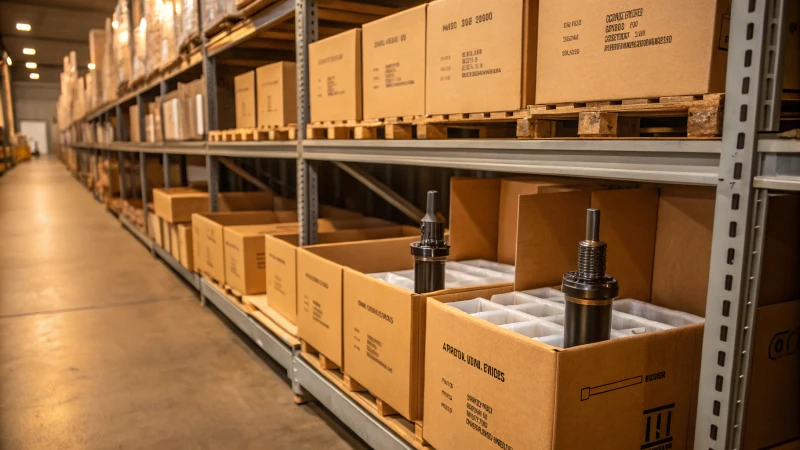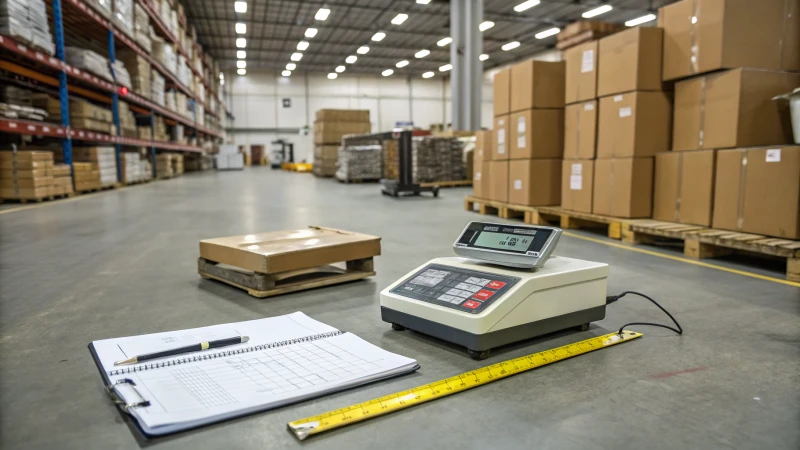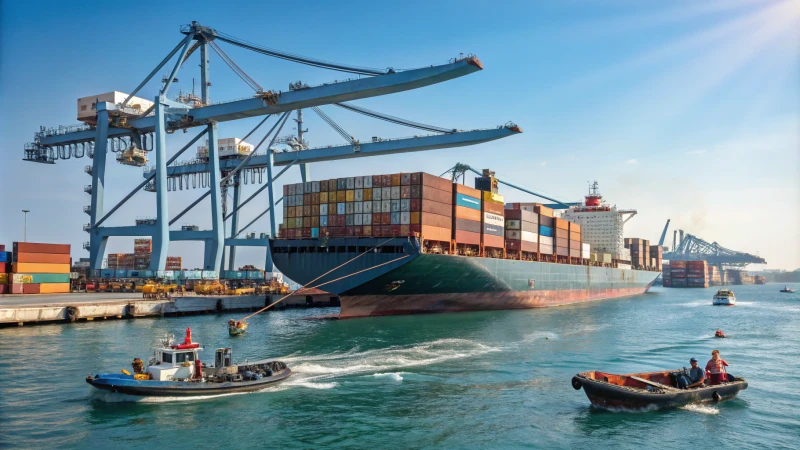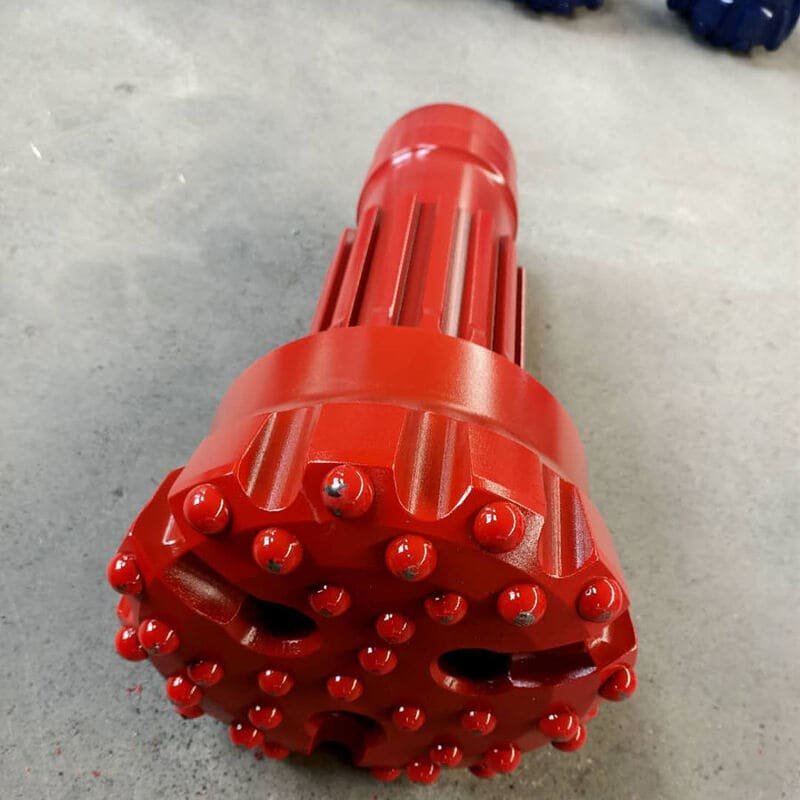Shipping DTH drill bits by sea can feel like navigating a stormy sea of complexities, but understanding key factors can make the voyage smoother.
To ship DTH drill bits by sea effectively, focus on solid packaging, corrosion prevention, precise documentation, reliable shipping partners, weight accuracy, and comprehensive tracking and insurance.
I remember my first time arranging a shipment for DTH drill bits. It was daunting! But diving deeper into each factor truly made a difference. Let’s break it down together: from securing sturdy packaging that stands up to the journey to ensuring every document is in order for smooth sailing through customs. Each step is crucial for keeping costs down and efficiency up. Let's explore these essentials to ensure your shipments are both secure and compliant.
Robust packaging is essential for shipping DTH drill bits by sea.True
Proper packaging prevents damage and ensures safe delivery during transit.
Weight accuracy is irrelevant when shipping DTH drill bits by sea.False
Accurate weight is crucial for cost estimation and compliance with regulations.
How Can You Optimize Packaging for DTH Drill Bits?
Ever wondered how to keep your DTH drill bits safe and sound during their globe-trotting adventures?
To optimize packaging for DTH drill bits, use strong materials, secure them to prevent movement, apply anti-corrosion treatments, and follow international labeling and shipping standards.

When I first tackled the task of optimizing DTH drill bit packaging, I remember standing in the warehouse, surrounded by boxes and bubble wrap, feeling a bit like an overwhelmed parent trying to pack for a family vacation. It was clear that using the right materials was crucial not just for protection but also for peace of mind.
Choosing the Right Materials
I quickly learned that picking the right packaging materials was like selecting armor for these drill bits. They needed to withstand tough journeys through various climates. Industrial-grade materials were my go-to, acting as sturdy shields against physical damage. And let’s not forget about moisture barriers and protective wraps1—my heroes against rust and dust. They ensured each bit was wrapped tighter than a Christmas present under the tree.
| Material Type | Benefits |
|---|---|
| Industrial-grade | Resists physical damage |
| Moisture barriers | Prevents rust and corrosion |
| Protective wraps | Guards against dust exposure |
Secure Storage Solutions
Securing these bits was another puzzle. I once tried a DIY solution using foam padding and custom inserts—imagine playing Tetris with drill bits. Each piece had its snug spot, ensuring it wouldn’t jiggle around during transit.
- Foam Padding: Offers cushioning and reduces shock.
- Custom Inserts: Ensures each bit stays in place.
Corrosion Prevention Techniques
Then came the battle against corrosion, where I felt like a warrior armed with anti-corrosion agents. These magical coatings provided an extra layer of protection, ensuring that when the bits finally reached their destination, they were as pristine as the day they left.
- Anti-Corrosion Agents: Provides a protective layer.
- Dry Storage Conditions: Reduces moisture exposure by storing them in dry environments2.
Documentation and Compliance
The paperwork side of things was like learning a new language. But once I got the hang of labeling and regulation adherence, it was smooth sailing—or in this case, drilling. Clear labels ensured our packages breezed through customs like VIP guests.
- Labeling: Clear instructions for handlers facilitate smooth customs clearance3.
- Regulation Adherence: Avoids legal complications.
Monitoring and Insurance
Finally, I discovered the magic of tracking systems and insurance coverage. With these in place, I could monitor every step of the journey, knowing we were covered in case of mishaps.
- Tracking Systems: Ensures real-time monitoring with secure fastening methods4.
- Insurance Coverage: Protects against potential losses.
Optimizing packaging wasn't just about following a checklist—it became a story of trial and triumph, with each package telling a tale of care and precision.
Moisture barriers prevent rust on drill bits.True
Moisture barriers shield drill bits from humidity, preventing rust.
Custom inserts allow drill bits to move freely.False
Custom inserts secure drill bits, preventing movement during transit.
How Can I Best Prevent Corrosion?
Ever felt that sinking feeling when rust eats away at your metal fixtures? It's like watching your hard-earned investments dissolve!
To effectively prevent corrosion, focus on regular maintenance, smart material choices, applying protective coatings, and managing environmental conditions. These practices are key to preserving metal structures and cutting down repair expenses.

Understanding Corrosion Mechanisms
Corrosion is like a silent, persistent force of nature. It's what happens when metal reacts with its environment—similar to how a cut apple turns brown when left out too long. Knowing the different types of corrosion processes5 is crucial. For example, uniform corrosion spreads over the whole surface, while pitting is sneakier, attacking specific spots.
Material Selection
Choosing the right materials is half the battle in preventing corrosion. I once had a project where we switched to stainless steel and alloys like titanium6 because they come with an amazing built-in shield against corrosion. The trick is to match the material to your environment.
| Material | Key Properties |
|---|---|
| Stainless Steel | High resistance to rust and staining |
| Titanium | Lightweight with superior corrosion resistance |
| Alloys | Customizable for specific environments |
Protective Coatings
Protective coatings are a relief when dealing with corrosion. Applying paints, epoxies, or galvanization creates a barrier against corrosive elements. Regular inspections are crucial, especially when you're dealing with specialized coatings7 in marine environments.
Environmental Control
Controlling the environment can save metal assets from premature aging—it was a game-changer for me. Dehumidifiers help keep moisture levels down, and careful use of de-icing salts can keep chlorides at bay. Implementing climate control systems8 in storage areas can be just as effective.
Regular Maintenance
Regular maintenance is essential—it's like brushing your teeth; if you skip it, problems build up. Cleaning surfaces to remove corrosive agents and reapplying protective coatings when needed can save headaches later on. Setting up a maintenance schedule9 ensures everything runs smoothly.
Cathodic Protection
Cathodic protection sounded like magic at first—using sacrificial anodes or impressed current systems to stop metal from oxidizing. It's common in pipelines and marine structures. Understanding the principles of cathodic protection10 can optimize its application and reduce constant worry.
By following these best practices, industries can effectively shield their infrastructure from corrosion, boosting durability and trimming down long-term costs.
Stainless steel is resistant to rust and staining.True
Stainless steel has a protective oxide layer that resists rust.
Cathodic protection is used for wooden structures.False
Cathodic protection prevents metal oxidation, not for wood.
Why is accurate documentation crucial for international shipping?
Ever tried sending a gift overseas only to find it stuck in customs? Imagine that on a grand scale with international shipping.
Accurate documentation is crucial for international shipping because it ensures regulatory compliance, facilitates timely customs clearance, and helps manage costs. Mistakes can lead to delays, legal problems, and financial losses, making meticulous record-keeping essential.

The Role of Documentation in Customs Clearance
When it comes to shipping internationally, I've learned the hard way that having all your paperwork in order is like having your passport at the ready. It’s not just about getting your goods from point A to point B; it’s about ensuring they glide smoothly through customs. Once, I had a shipment held up because of a missing Bill of Lading—trust me, the extra storage fees11 and legal headaches were a nightmare.
| Document Type | Purpose |
|---|---|
| Bill of Lading | Proof of shipment and receipt of goods |
| Commercial Invoice | Details the value and description of goods |
| Packing List | Specifies contents and packaging details |
| Certificate of Origin | Confirms the origin of the goods |
Avoiding Financial Losses
I remember a time when we misdeclared the value on a commercial invoice. It felt like a small oversight but led to hefty fines. That's when I realized how important it is to double-check every detail. Ensuring every document is accurate and submitted on time isn’t just about staying on the right side of the law—it’s about protecting your bottom line by effectively managing costs12.
Regulatory Compliance and Best Practices
Staying compliant with ever-changing regulations is non-negotiable. Accurate documentation helps businesses adhere to both domestic and international laws. Keeping up-to-date with these changes, like tariff adjustments, is something I've learned to prioritize. Once, using compliance software13 saved us from a potential disaster by flagging an outdated regulation we hadn't noticed.
Tips for Maintaining Accurate Documentation
- Regular Training: Ensure everyone handling documentation knows the latest regulations and best practices. I've found that training can prevent costly mistakes.
- Digital Solutions: Implementing digital tools has been a game-changer for us. It helps minimize human error and keeps everything organized.
- Consistent Audits: Regular audits have become a part of our routine. They help us catch errors early and avoid bigger problems down the line.
Following these practices has helped us keep our international shipping running like a well-oiled machine, ensuring we stay competitive in the global market.
Errors in shipping documents can cause legal issues.True
Incorrect documentation may lead to non-compliance with laws, causing legal problems.
Digital tools increase errors in shipping documentation.False
Digital solutions are implemented to reduce human error and improve accuracy.
How Do I Choose the Right Carrier for My Drill Bit Shipments?
Have you ever wondered how to ensure your drill bits arrive safely and on time? Choosing the right carrier is key.
To choose the right carrier for drill bit shipments, I assess their experience with similar cargo, weigh cost-effectiveness, check insurance coverage, and insist on reliable tracking options. This ensures my shipments are safe, timely, and keep my clients happy.

Evaluate Experience with Similar Cargo
I remember the first time I shipped drill bits—it was a nail-biting experience. I quickly learned to prioritize carriers familiar with transporting drilling equipment. These pros understand the unique challenges14 of handling hefty and sensitive items like drill bits. They've got it down to a science, from packing to securing the cargo.
Assess Cost-Effectiveness
Budgeting is always on my mind, but I've learned that the cheapest carrier isn't always the best choice. I look at the overall value: How's their reputation for on-time delivery? What about customer service? A cost comparison table helps me weigh options:
| Carrier | Experience Level | Cost | Additional Services |
|---|---|---|---|
| Carrier A | High | $$ | Insurance, Tracking |
| Carrier B | Medium | $ | Basic Service |
Verify Insurance Coverage
I can't tell you how many sleepless nights I've avoided by ensuring adequate insurance coverage for my shipments. This is non-negotiable for high-value shipments. A solid insurance policy means I'm protected against any unforeseen hiccups during transit.
Ensure Reliable Tracking Options
Real-time tracking is my peace of mind. It’s like having a GPS on my shipments, allowing me to adjust plans if delays pop up. I choose carriers that offer robust tracking solutions so I always know my shipment's status.
Consider International Regulations15
Shipping across borders? It can get tricky! I ensure the carrier knows the import/export regulations of all involved countries to dodge customs delays.
Evaluate Customer Support
Great customer support is a lifesaver when things go sideways. I opt for carriers known for their responsive teams who can tackle issues efficiently and keep my operations smooth.
By weighing these factors, I've been able to select carriers that align with my logistics needs and reduce risks associated with shipping drill bits.
Experienced carriers handle drill bits better.True
Carriers with experience understand the challenges of transporting drill bits.
Cheapest carrier always provides the best service.False
Cheapest options may lack reliability, affecting delivery and service quality.
Why Are Accurate Weights and Measurements Crucial in Shipping Costs?
I remember the first time I got hit with an unexpected shipping fee—it was a real eye-opener! Accurate weight and measurement are vital in shipping, impacting costs and preventing surprises.
Accurate weight and measurements are crucial in shipping as they directly affect cost calculations. Shipping companies rely on these metrics to set fees, ensure proper load distribution, and comply with regulations. Inaccuracies can lead to extra charges and delays.

The Basics of Shipping Cost Calculations
Imagine sending a gift to a friend, only to find out you paid twice as much because of its size! Shipping costs hinge on two main things: weight and dimensions. Carriers choose between actual weight or volumetric weight—whichever is higher. Volumetric weight considers how much space your package takes up.
Take that birthday gift, for example. A lightweight but bulky teddy bear could cost more to ship than you’d expect because it hogs space. By getting these measurements right, I’ve learned to dodge extra fees. Here’s a simple table to show how carriers might calculate costs:
| Factor | Description |
|---|---|
| Actual Weight | The physical weight of the package in kilograms or pounds. |
| Volumetric Weight | Calculated using the package's dimensions (LxWxH) divided by a divisor. |
Importance of Accuracy in Shipping
I've been there—facing penalties because I underestimated a package's size. Accurate data is key to avoiding these surprises. Here’s how it helps:
- Avoiding Penalties: Trust me, penalties for inaccurate measurements can hit you where it hurts—in your wallet. It’s not just about extra charges; delays can also mess up your delivery timelines.
- Optimizing Packaging: Knowing the exact size and weight helps me pick the perfect packaging, cutting down on wasted space and materials.
Technology's Role in Ensuring Accuracy
With all the advancements, keeping accurate records has become a breeze! Tools like digital scales and dimensioners have become my best friends in logistics. They streamline operations, cut down human error, and provide real-time data for efficient decisions.
Utilizing these tools can streamline the process, minimize human error, and provide real-time data for efficient decision-making in logistics operations16.
Regulatory Compliance and Its Impact
Shipping internationally? I’ve learned that playing by the rules is non-negotiable. Accurate weight and measurement data are often needed for regulatory compliance. Think international shipping regulations17 requiring precise package details.
Non-compliance can lead to fines or your goods being held at customs—a costly mistake. So, while getting the measurements right may seem straightforward, it's a critical aspect of cost management, operational efficiency, and compliance in the shipping world.
Volumetric weight affects shipping cost more than actual weight.False
Shipping costs are determined by the greater of actual or volumetric weight.
Digital scales improve accuracy in shipping measurements.True
Digital scales reduce human error, ensuring precise weight data for shipments.
How Does Tracking and Insurance Impact Your Shipping Strategy?
Ever had a package lost in transit or arrive damaged? Understanding how tracking and insurance affect your shipping strategy can save you from these nightmares.
Tracking lets me see my shipments' journey in real-time, boosting customer happiness and making operations smoother. Insurance steps in as a safety net, covering financial losses from any hiccups with lost or damaged goods, making it essential for a strong shipping strategy.

The Role of Tracking in Shipping
I remember the first time I decided to implement a tracking system for my shipments. It was a game-changer! Suddenly, I wasn't just sending packages into the void, hoping they'd reach their destination. I could see exactly where they were at any given moment. My customers loved it too—they felt more in control, knowing when to expect their deliveries.
- Benefits: Tracking systems have significantly improved customer satisfaction18 by providing timely delivery updates. Just imagine the relief of knowing exactly when your package will arrive.
- Challenges: The downside? It required a bit of an upfront investment in technology and some tweaking to fit into our existing systems.
But once everything was up and running, tracking also helped us optimize delivery routes, slashing transit times and saving on costs.
Importance of Shipping Insurance
I learned the hard way about the importance of insurance. One high-value shipment got damaged in transit, and I was left holding the bag. That was when I realized: insurance isn't just a nice-to-have; it's a must-have.
- Benefits: It reduces financial risk by covering the costs of lost or damaged goods. Especially for those high-ticket items, having insurance is like having peace of mind.
- Considerations: Of course, not all policies are created equal, so I had to spend some time finding one that really fit my business needs.
Balancing Tracking and Insurance Costs
Balancing the costs of these services is like walking a tightrope. On one hand, they add immense value; on the other hand, they do cost money. So I constantly ask myself: Are the benefits worth the price?
| Factor | Tracking | Insurance |
|---|---|---|
| Cost | Initial setup and ongoing maintenance | Premiums vary based on shipment value and destination |
| Value | Enhanced customer experience19 through transparency | Protection against unexpected losses |
| Implementation | Requires tech integration and staff training | Needs understanding of policy terms and claim processes |
Real-World Examples and Case Studies
Imagine you're running a business shipping high-value electronics. By integrating tracking systems, you can offer precise delivery timelines that enhance client trust. Pairing this with insurance ensures financial protection against potential mishaps.
Or think about e-commerce platforms20 during peak seasons when shipments increase dramatically. They often rely on both tools to manage shipping efficiently.
These stories show just how strategic tracking and insurance are in keeping logistics smooth and maintaining a competitive edge.
Tracking systems improve customer satisfaction.True
Real-time updates enhance transparency, boosting trust and satisfaction.
Shipping insurance is unnecessary for high-value goods.False
Insurance protects against financial loss from damage or theft.
Conclusion
Shipping DTH drill bits by sea requires careful consideration of packaging, corrosion prevention, documentation, reliable carriers, weight accuracy, and tracking to ensure safe and efficient delivery.
-
Explore how different moisture barriers protect against humidity and dust, ensuring the longevity of DTH drill bits. ↩
-
Learn about dry storage benefits in preventing rust and corrosion on metal tools like DTH drill bits. ↩
-
Understand international labeling regulations to ensure compliance and smooth customs clearance for shipments. ↩
-
Discover secure fastening methods to prevent movement of drill bits during transit, ensuring they remain intact. ↩
-
Explore various corrosion processes to better understand which might affect your materials and how to address them effectively. ↩
-
Learn why titanium is an excellent choice for preventing corrosion, especially in harsh environments. ↩
-
Discover specialized coatings designed to protect against the harsh marine environment, ideal for structures exposed to saltwater. ↩
-
Understand how climate control systems can help maintain optimal conditions to prevent corrosion. ↩
-
Learn how a structured maintenance schedule can significantly reduce the risk of corrosion in industrial settings. ↩
-
Explore cathodic protection techniques that can shield metal structures from corrosion, especially in corrosive environments. ↩
-
Understanding storage fees helps in planning budgetary requirements for potential customs delays. ↩
-
Effective cost management is essential to maintain profitability and avoid unexpected financial burdens. ↩
-
Compliance software aids in ensuring adherence to ever-evolving international trade regulations. ↩
-
This link will provide insights into why experienced carriers are better suited for handling heavy and specialized equipment like drill bits. ↩
-
Understanding international regulations can prevent customs delays, ensuring timely delivery of shipments. ↩
-
Exploring this link can provide insights into advanced tools that enhance accuracy in logistics, helping streamline operations and reduce costs. ↩
-
Understanding international shipping documentation can help avoid legal issues and ensure smooth transactions across borders. ↩
-
Discover how real-time tracking enhances customer satisfaction by providing transparency and reliability. ↩
-
Learn how tracking systems enhance the overall customer experience through improved service delivery. ↩
-
Explore how leading e-commerce platforms efficiently use tracking and insurance to manage shipments. ↩








